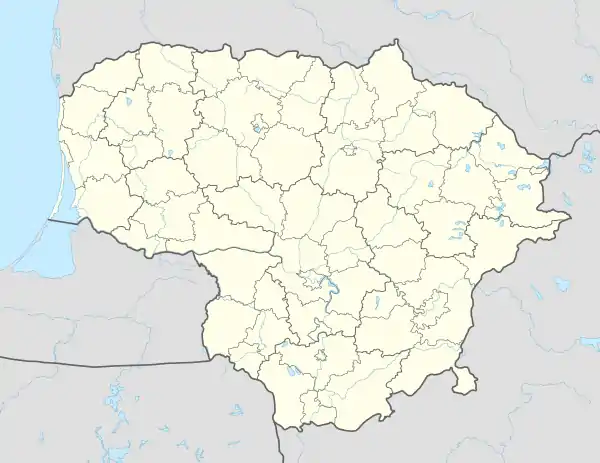Bazilionai
Bazilionai is a small town in Šiauliai County in northern-central Lithuania. It is situated on the bank of the Dubysa River about 2 kilometres (1.2 mi) of the road connecting Šiauliai with Sovetsk (former trade route to Tilsit).[1] As of 2011, the estimated population was 390.[2]
Bazilionai | |
|---|---|
Town | |
 Bazilionai town centre | |
|
Coat of arms | |
 Bazilionai Location in Lithuania | |
| Coordinates: 55°47′40″N 23°08′20″E | |
| Country | |
| Ethnographic region | Samogitia |
| County | Šiauliai County |
| Municipality | Šiauliai district municipality |
| Eldership | Bubiai eldership |
| Population (2011) | |
| • Total | 390 |
| Time zone | UTC+2 (EET) |
| • Summer (DST) | UTC+3 (EEST) |
History
In 1744, King Augustus III granted a privilege to organize regular fairs in the town.[3] Before monks of the Order of Saint Basil the Great arrived to the town in 1749, it was known as Padubysys (literally: near Dubysa).[1]
The Basilian Fathers established a parish school in 1773. After 20 years, the school had 192 students and was reorganized into six-year school.[3] The monastery and school was closed by the Tsarist authorities after the failed uprising in 1830.[3]
The town church was transformed into an Eastern Orthodox one. After Lithuania regained independence in 1919, the church was reformed back to a Catholic one.[3]
Before World War II, the Jewish community of the village had 130 members. All of them were murdered in a mass execution perpetrated by an einsatzgruppen of Germans and Lithuanian nationalists in 1941.[4][5]
References
- Semaška, Algimantas (2006). Kelionių vadovas po Lietuvą: 1000 lankytinų vietovių norintiems geriau pažinti gimtąjį kraštą (in Lithuanian) (4th ed.). Vilnius: Algimantas. p. 225. ISBN 9986-509-90-4.
- "2011 census". Statistikos Departamentas (Lithuania). Retrieved August 16, 2017.
- Kviklys, Bronius (1968). Mūsų Lietuva (in Lithuanian). Vol. IV. Boston: Lietuvių enciklopedijos leidykla. p. 480. OCLC 3303503.
- "Yahad - in Unum".
- "המכון הבין-לאומי לחקר השואה - יד ושם".
External links
- (in Lithuanian) Website of Bazilionai community